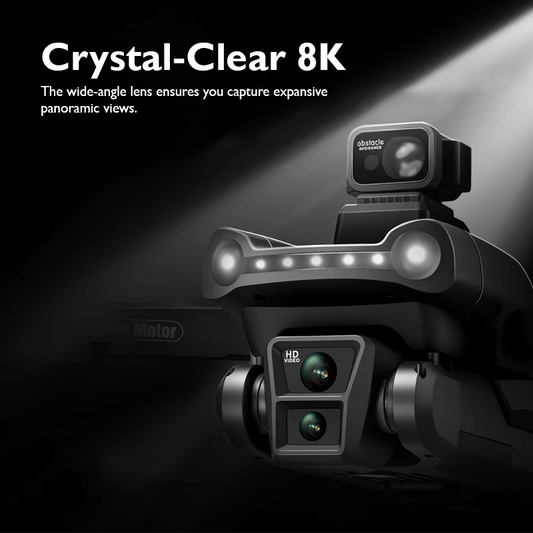The Best Practices for Drone Use in Wildlife Documentary Filmmaking

In the realm of wildlife documentary filmmaking, every shot is a testament to the raw beauty and untamed wonders of nature. And with the advent of technology, capturing these moments has become more immersive and breathtaking than ever before. Enter drones – the silent, aerial marvels that have revolutionized the way filmmakers approach wildlife cinematography.
But with great power comes great responsibility. As filmmakers, it's crucial to understand the best practices for drone use in wildlife documentary filmmaking to ensure both the safety of the animals and the integrity of the footage captured. In this guide, we delve into the essential dos and don'ts, techniques, and considerations for mastering the skies and creating mesmerizing wildlife documentaries.
1.Understanding the Landscape

Before taking flight, it's imperative to familiarize yourself with the terrain and the wildlife you intend to film. Conduct thorough research on the species inhabiting the area, their behavior patterns, and any regulations or restrictions imposed on drone usage in the region. By understanding the landscape, you can plan your shots more effectively and minimize disturbances to the natural environment.
2.Respect Wildlife and Their Habitat

Respect for wildlife and their habitat should always be the top priority when using drones for filmmaking. Avoid disrupting the natural behavior of animals, especially during sensitive times such as mating seasons or periods of migration. Maintain a safe distance from wildlife to prevent undue stress or interference.
Furthermore, be mindful of the impact that drone noise may have on animals. Some species are particularly sensitive to sound disturbances, so keeping noise levels to a minimum can help mitigate any potential disruptions.
3.Safety First

Safety is paramount when operating drones in any environment, but it takes on added significance when filming wildlife. Ensure that you are well-versed in drone operation and abide by all relevant safety guidelines and regulations. Conduct pre-flight checks to verify that the drone is in optimal condition and that all systems are functioning correctly.
Additionally, always have a contingency plan in place for emergencies, such as drone malfunctions or unexpected weather conditions. Being prepared can help prevent accidents and protect both your equipment and the surrounding environment.
4.Choose the Right Equipment

Selecting the appropriate equipment is essential for achieving high-quality footage while minimizing the impact on wildlife. Opt for drones with quiet propulsion systems to reduce noise pollution and disturbance to animals. Additionally, consider using drones equipped with obstacle avoidance technology to navigate challenging terrain safely.
When choosing camera equipment, prioritize lightweight and compact options that offer high-resolution capabilities. This allows for greater flexibility in capturing dynamic shots while minimizing the overall footprint of your setup.
5.Plan Your Shots Strategically

Effective shot planning is key to capturing compelling footage that tells a cohesive story. Take the time to scout the area beforehand and identify potential filming locations and subjects of interest. Consider factors such as lighting conditions, background scenery, and the movement patterns of wildlife when planning your shots.
Utilize a combination of aerial perspectives and ground-level shots to provide viewers with a comprehensive view of the environment. Experiment with different camera angles and movements to add depth and visual interest to your footage.
6.Fly Responsibly

When flying drones in wildlife habitats, it's essential to adhere to responsible flying practices to minimize disturbance to the natural environment. Avoid flying directly over animals or nesting sites, as this can cause unnecessary stress and agitation.
Maintain a safe distance from wildlife and refrain from pursuing them or altering their behavior for the sake of capturing a shot. Remember that the welfare of the animals should always take precedence over getting the perfect footage.
7.Consider Environmental Factors

Environmental conditions can significantly impact drone operation and the quality of footage captured. Be mindful of factors such as wind speed, temperature, and humidity, as these can affect flight stability and battery life. Plan your filming schedule accordingly to optimize conditions for aerial filming.
Additionally, be mindful of any environmental regulations or protected areas in the vicinity. Ensure that your drone operations comply with local laws and regulations to avoid any legal repercussions.
8.Post-Production Considerations

Once you've captured your footage, post-production editing plays a crucial role in enhancing the visual appeal of your wildlife documentary. Utilize editing software to fine-tune colors, adjust contrast, and stabilize shaky footage. Incorporate captivating sound effects and music to complement the visuals and evoke an emotional response from viewers.
Prioritize authenticity and integrity in your editing process, avoiding excessive manipulation or embellishment of the footage. The goal is to present an accurate portrayal of the natural world while captivating audiences with stunning visuals and compelling storytelling.
Mastering the art of drone use in wildlife documentary filmmaking requires a delicate balance of technical skill, creativity, and respect for the natural world. By adhering to the best practices outlined in this guide, filmmakers can create immersive and awe-inspiring documentaries that showcase the beauty and diversity of our planet's wildlife.
From understanding the landscape and respecting wildlife to prioritizing safety and responsible flying practices, each aspect of drone filmmaking plays a crucial role in capturing breathtaking footage while minimizing disturbance to the environment. By following these guidelines, filmmakers can harness the power of drones to elevate their storytelling and inspire audiences to appreciate and protect the wonders of the natural world.
Explore a variety of drones at our online drone store.Happy Flying!











